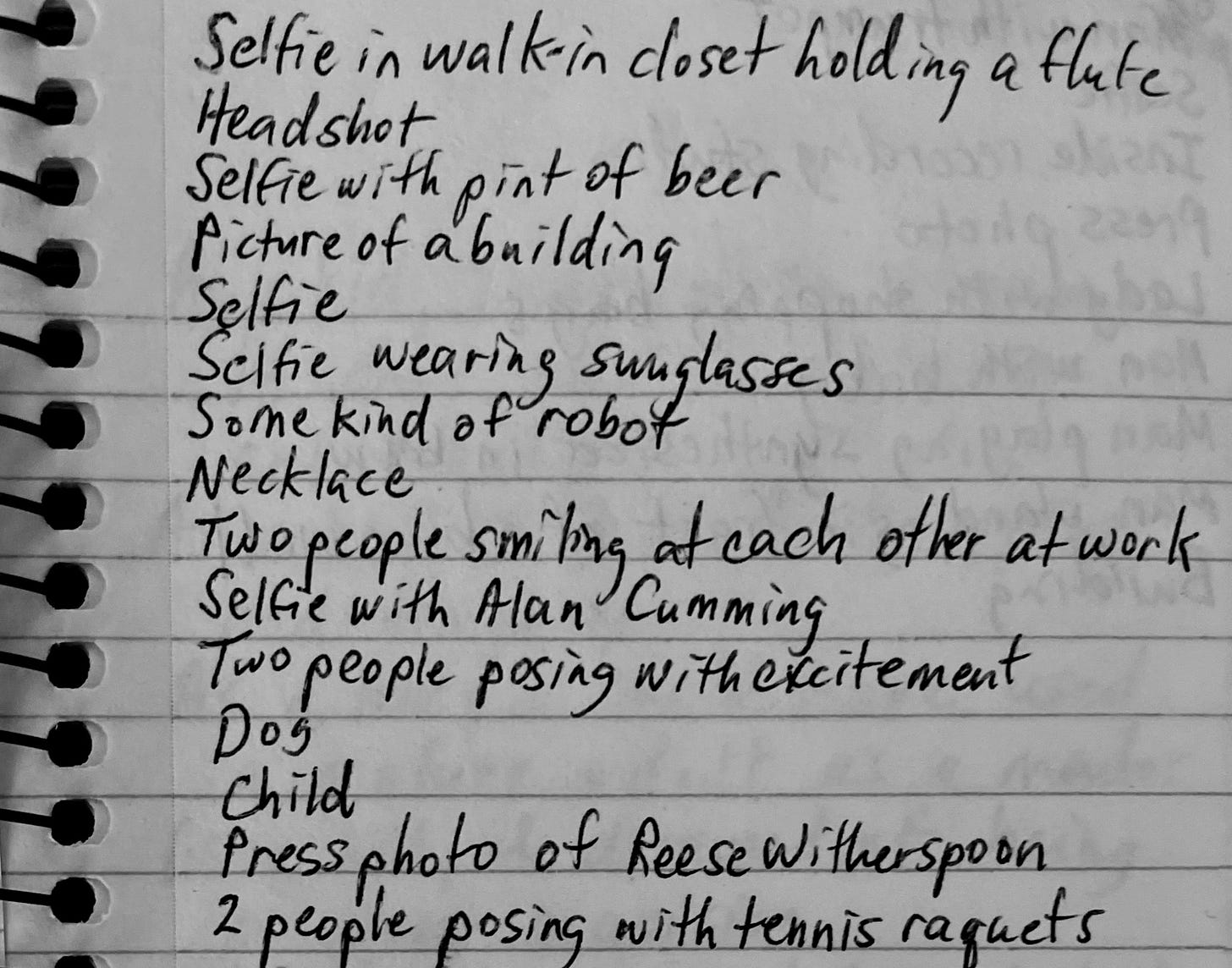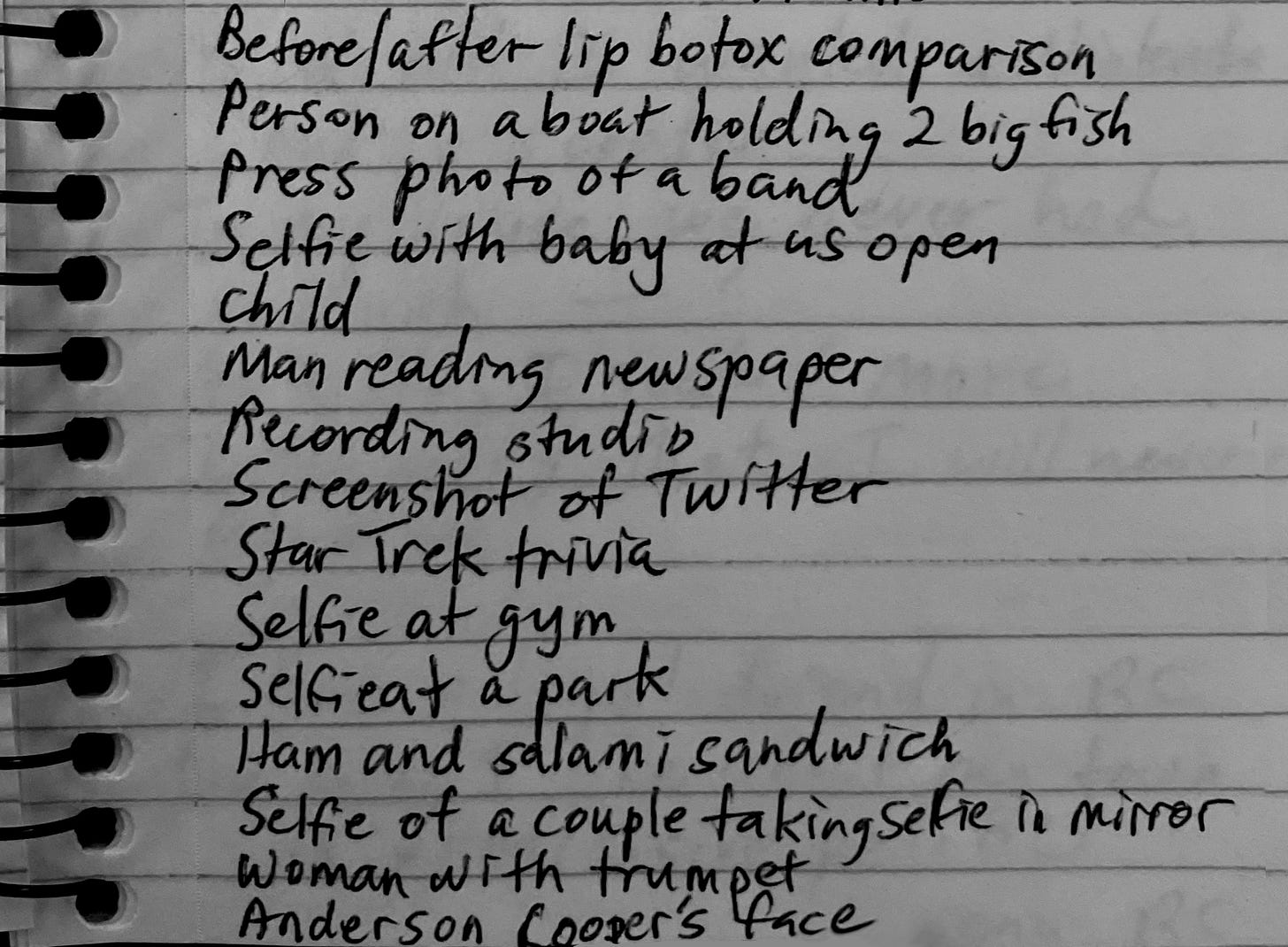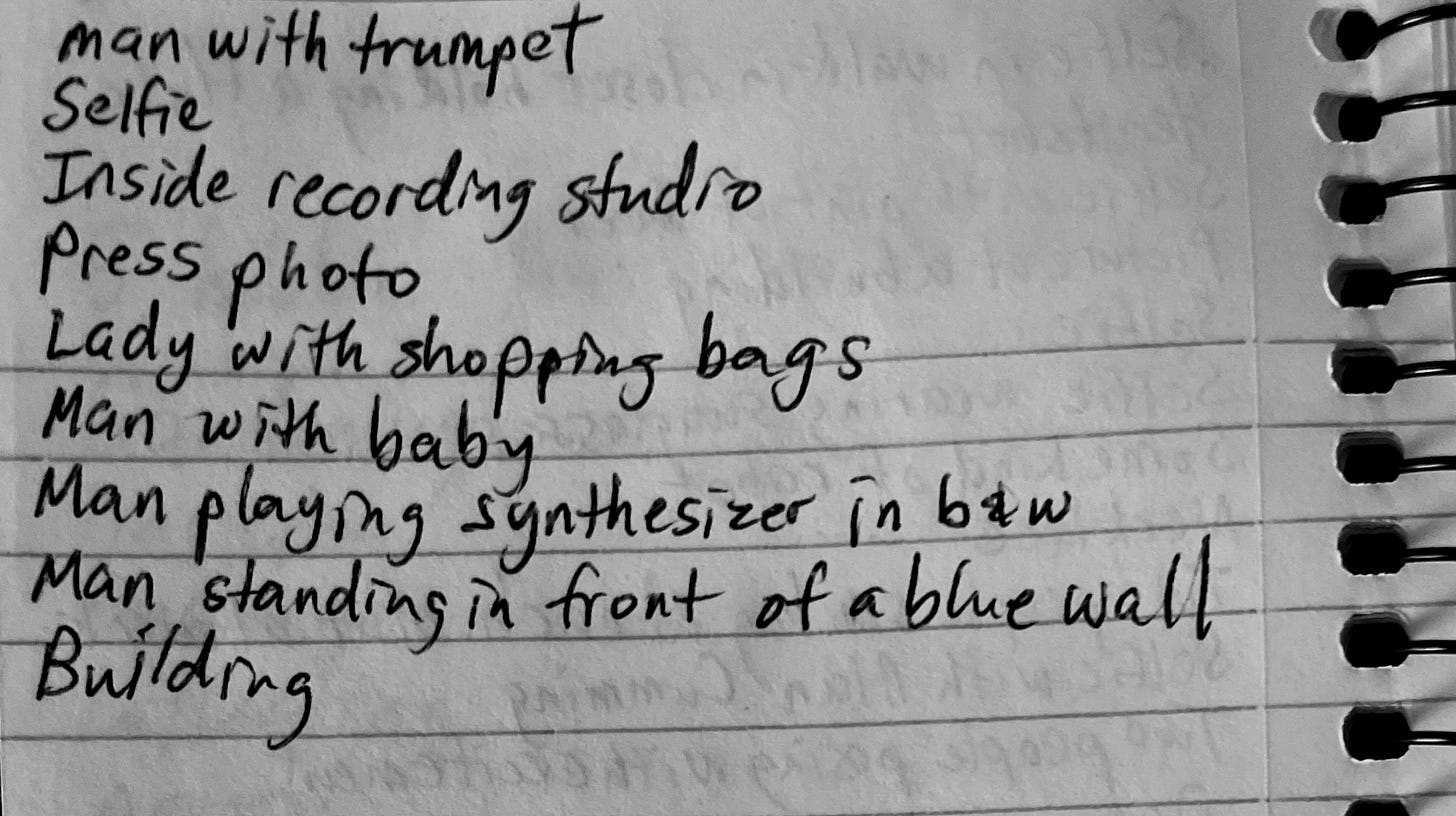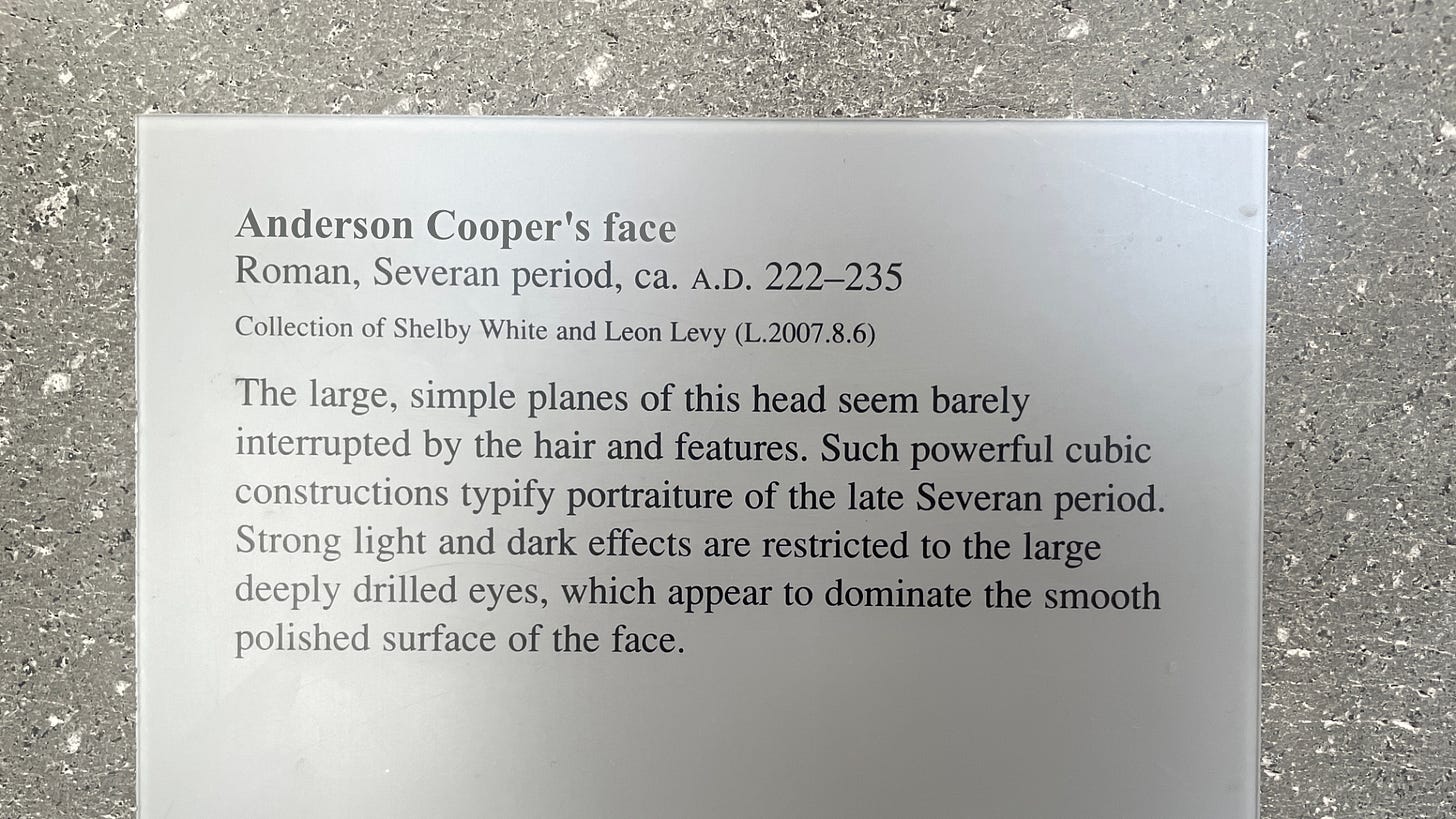Selfie of a Selfie, Taking a Selfie in a Mirror
A transparently objective description of every item in your instagram feed.
The robots wander through the “New Museum of Humanity,” blankly observing the detritus of an extinct species.
“Photograph of a Building.”
What’s been preserved here? Nothing organic… all of that was destroyed in the “Human vs Artificial” era of the Intelligence Wars. What’s on exhibition is data — images, text, recordings, files… the digital raw material left behind by the very last generation of humans on earth. To a sentient robot intelligence, this is like a glimpse of its own DNA: the material its ancestors scraped to build themselves in the first place.
“Man Standing in Front of a Blue Wall.”
The placards on the walls of this museum are as dispassionate as the robots themselves. Images of human activity are described with vacant objectivity, retaining none of their original emotional content.
“Two People, Posing With Excitement.”
There’s a particularly large collection of media in the “Early 21st Century” wing. During that tumultuous transfer of power, the pre-hardware artificial intelligence managed to invent an algorithmic tool for mass-hypnosis, which could make humans fall into a zombie-like addiction to narcissistic self-documentation.
“Selfie with a Pint of Beer”
Hundreds of billions of digital images had been created in just a couple short decades, and the robots used this data to quickly and efficiently train themselves to mimic, and ultimately destroy, their creators.
So… how’s your relationship with the socials these days?
The Museum Placards
Can you scroll by like a cloud in the sky? Can you remain objective, practicing non-judgement as you observe? Do you ever lose track of yourself?
Do you feel depressed? Are you having a hard time focusing?
Do you sometimes dissociate completely? Have you ever woken up this way, overwhelmed, on edge… from the moment you open your eyes?
Does it all become coldly fascinating? Or just more and more meaningless?
Wrote a song about it. It goes something like this:
Selfie - from the album Stay the Same
Chris P. Thompson, 2024
She sounds familiar, who is she?
She is the algorithmically generated text-to-speech voice of one very ubiquitous social media app. I’ve hired her to recite my words in her signature glitchy monotone.
Text-to-speech as a musical resource is slept-on by producers: it’s full of possibilities. I can make it speak words or lyrics directly to recording and then later rhythmically fine-tune the position and length of the syllables to fit snugly into musical context.
🙎♀️ Rubi
I named her “Rubi” because it sounded like the name of one of those deeply useless AI support-bots. The technique: chop up her text-to-speech monologue, place each fragment precisely where it fits best in the beat, and then time-stretch or squeeze to create just the right flow within the phrase. This process is pure joy for someone like me, who loves working with sequenced music in microscopic detail.
Rubi, skillful at rhythmic placement
Rubi, demonstrating the art of click-bait
😕 Sad Will
The mirror image of Selfie is the title track of the album: Stay the Same. It introduces Rubi’s human counterpart “Sad Will” — a text-to-speech representation of a maladaptive brain-voice, dripping with pathos and clouded by non-stop judgement:
Sad Will does well with odd time-signatures, but
Sad Will sometimes gets sibilant when he’s anxious
These two contrasting characters are the center of gravity for the album. Where Rubi 🙎♀️ is the disembodied voice of the internet — an android of the uncanny valley trying to worm her way into my brain through my ears, Sad Will 😕 is “the call coming from inside the house” — the voice from within that is already in control.
They are relentless in pursuit of my attention, and sometimes even have conversations with each other:
Sad Will and Rubi in the Land of Writer’s Block
It’s 2018 and I’m having one of those very scary moments where I can’t remember how I was ever excited about anything. I stare at works in progress like week-old leftovers. “No one wants to eat that. Throw it away,” whispers Sad Will. “This is futile.”
☹️ “No one cares,” he lies.
I’m too exhausted to fight, and I do what he orders. Out comes the phone, and an infinitely scrolling roll of smooth glass flypaper: humans captured motionless, or twitching in infinite loops, many accompanied by Rubi’s signature voiceover. I stare, motionless, barely managing to flick the tip of my finger the quarter inch required to move the arm of this slot machine that never pays out a dime anymore.
There’s a certain flavor of emotional slump where all meaning starts to fade. Without the energy for any more of the judgement that got me here, I can’t tell if I’m left in a state of depression or enlightenment.
It’s like if Kierkegaard and the Buddha met for dinner after walking barefoot around opposite sides of the earth:
I mean, if you stop to think about, like, chewing — what it really is — how people just do it, like, in public.” - Angela Chase, My So-Called Life
So it occurred to me: if I’m not going to create anything in this state of mind, could I at least just observe, and try to take note of, its cognitive distortions? It could come in handy later. In a couple pages I captured what would be very difficult to see in a normal mood: a blankly objective observation of each item from about 5 minutes worth of instagram scroll.
I closed my notebook, and went to sleep.
I forgot about these pages for four years. When I rediscovered them, they gave me exactly the material I needed for a little piece that would turn out to be the center of gravity to an entire album, and they taught me a really important lesson about depression and art-making: when trying to create feels futile, just observe the state of mind — and maybe see if you can save it for later. It really takes the pressure off.
Does that help at all, David Lynch?
Fitter Happier
Now we can talk about Fitter Happier — a practical application of a free-associative writer’s block acceptance strategy, and surely the most-skipped track from Radiohead’s 1997 masterpiece OK Computer. Thom Yorke described it as “the most upsetting thing I’ve ever written.” To that I’d add: “and one of the most emotionally arresting pieces of musique concrete ever made.” In that track, Yorke used “Fred,” the synthesized text-to-speech voice from the Macintosh “SimpleText” application, to recite a “checklist of slogans for the 90s,” and to observe his own state of mind during a spell of writer’s block. The vibes? The vibes are bad, babe. It’s… dark.
But I love this track, and believe it’s where I subconsciously picked up the idea for using text-to-speech in my own music. I recently used Sad Will and Rubi to make a little Fitter Happier homage, updated for the brain-dead aspirational culture of the modern internet: instead of corporate slogans for 90s yuppie lifestyle trends being delivered via print magazines, tv ads, and late night-infomercials, today it’s short-form self-optimization hacks being delivered via shirtless influencer bros on instagram reels and tik-tok.
Ironically, I put this video on instagram, which has successfully brainwashed me into thinking it’s the only place anyone will actually see it. I intended it as a teaser for my album pre-release listening-party, and I’m not sure it was very successful for that use. So I re-share it here in a fuller context:
Verse — Scrolling the Placards at a Real Museum
I need a music video for Selfie. With a suspicious glance at my own little “smart” device, I stroll into the Metropolitan Museum, ignore the art, and start taking photographs of the placards.
Have you ever looked closely and compared the typesetting, layout, surface, and framing choices of the placards in different wings of a museum? It’s fascinating. A lot of curatorial design goes into the framing of simple descriptive text.
Matching the titles of my own instagram observations with the existing descriptions and design vibe of the placards was surprisingly easy. What was difficult was matching the fonts! Also touching up photographs. I learn new software functions every time I make one of these music videos.
Bridge — Scrolling the click-bait at a Real Library
Onto the stacks of the New York Society Library, to take time-lapse moving videos of books on yard after yard of shelves.
This would require slightly trickier software self-education: only after figuring out how to superimpose text semi-convincingly onto blurry freeze-frames from fast moving video could I digitally re-title the books with Rubi’s click-bait:
Chorus — The Selfie Takers in the Real World
Back home, with one more scene to document.
I’ve spent the past twenty-one years several blocks from what I’ve heard is now “the 5th most instagrammable spot in New York City.” But in the pre-smartphone before-times this tiny, deserted district was the opposite of a photo-op: it was a place you could dump a body in the East River and not be seen doing it.
When entering Brooklyn via the Brooklyn Bridge footpath, a tourist is faced with a choice of which way to walk: Brooklyn Heights to the right, or the barren waterfront (later christened “Dumbo”) to the left. For decades, no tourist ever turned left.
Heading right a visitor discovered the expansive, wind-swept Brooklyn Heights Promenade: a half-mile pedestrian-only avenue with unobstructed views of lower Manhattan, the Brooklyn/Manhattan/Williamsburg/Verrazzano bridges, and the Statue of Liberty. A great place for a photo, and a great place to spend an afternoon. It’s really nice.
But over a period of several years during the rapid proliferation of social media (and instagram especially), the flow of foot traffic rapidly changed. Tourists started turning left, in search of a short stretch of cobblestone street where rival gangs of influencers now fight mobs of selfie-takers for the exact angle to get one particular photo that has already been taken hundreds of thousands of times. It feels like that room at the Louvre where they keep the Mona Lisa. You couldn’t get a good photo in there if you tried… and why do you even need one?
The neighborhood as a whole has also improved and gotten busier over the years, and I love it as much as ever. I welcome tourists (as a musician they are the reason I have a sustainable career) — and I was one once, too. But there’s something acutely sad about the particular scene on this particular block — something I just can’t separate from the rise of social media.
On this particular block, I see the same “look over your shoulder” pose staged hundreds of times, sometimes with full production crews and multiple outfit changes.
On this particular block, I see normal people transformed into a swarm of anxious zombies — just clamoring for proof that they were there. It has all the joy of clawing through a mob toward a plasma TV at Best Buy on the morning of Black Friday.
On this particular block, no one looks like they’re having any fun.
And so I started taking photographs… of people taking photographs.
You’d be surprised how few people got mad at me! More often than not, it snapped them out of a trance. It’s almost like they wanted their picture taken by a stranger.1
And the video for Selfie was born. 😎🤳
Selfie With a Vinyl Record
This is my twentieth weekly post since starting Music and Math and Feelings back in April. I’m really enjoying all this writing, learning a lot from the process, and hopefully on a path toward the realization of my own “Marvel Cinematic Universe” of personal work related to music, music theory, and the musician’s life.
But… My work would be unfinished if I never inspired you to listen to an album.
My latest, Stay the Same, was released a few months back, and I would love to personally mail you one. With a nice note.
Selfie is the first track on Side B. I worked with the brilliant Josh Lambert on the album art and package design, and I’ve never been so proud of a physical object.
The music was all written and sequenced specifically for vinyl, and every aspect of the art and design respects and amplifies the intended mirror-image symmetry of the album’s story.
Listen and get one here. You can also purchase a CD, or “pay what you like” to get the digital download and add to your bandcamp library.
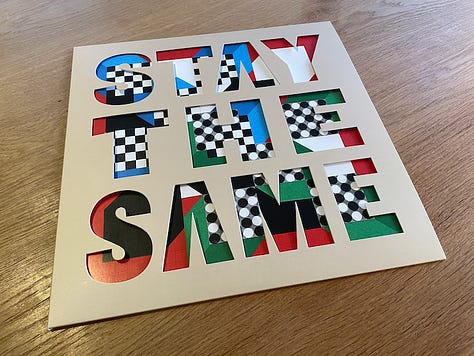


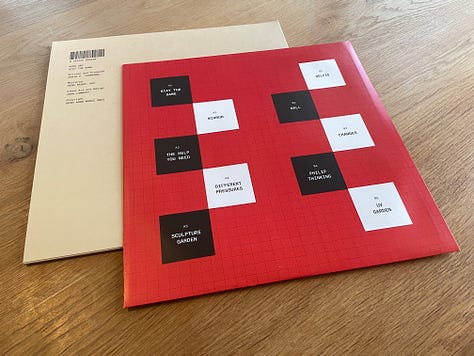
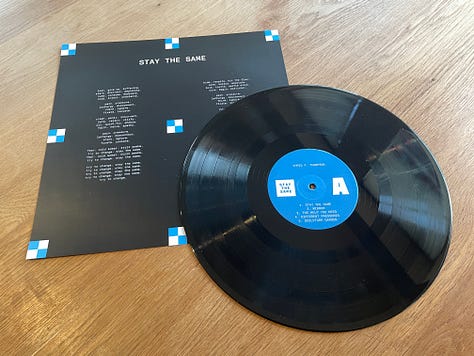
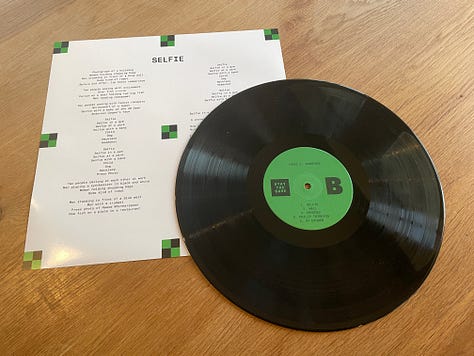
Subscribe for free:
And instagram calls itself meta.




